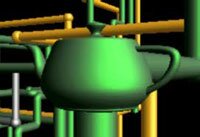visits
1636
votes
7
votes++Vote positively this post :)
+32
votes--Vote negatively this post :(
-25
The Newell's teapot


 It's origin comes from the year 1975, when the mathematic Martin Newell was sitting the basis of the 3D geometry for the generation of computer graphics. For this task he needed a simple object that the computer could move fluently and that had certain characteristics as, for instance, parts that did shadows or was self-reflectives, rounded parts, others partially convex, etc. Newell commented to his wife that didn't have a lot of interesting models to do his work and she suggested that use the tea set that they were using. Between the objects of the tea set was the teapot that you see in the photo and which is exposed actually in the "Computer History Museum" on California:
It's origin comes from the year 1975, when the mathematic Martin Newell was sitting the basis of the 3D geometry for the generation of computer graphics. For this task he needed a simple object that the computer could move fluently and that had certain characteristics as, for instance, parts that did shadows or was self-reflectives, rounded parts, others partially convex, etc. Newell commented to his wife that didn't have a lot of interesting models to do his work and she suggested that use the tea set that they were using. Between the objects of the tea set was the teapot that you see in the photo and which is exposed actually in the "Computer History Museum" on California:

 Newell drew by hand over a graph paper the mesh that defined the teapot, a spoon, a cup, a dish and a milk jug, to enter the principal points of each object in his computer with Bézier curves, starting from this and with some algorithms, created a mathematical model for each one. After published the models freely to the scientific community, a lot of them begins to use the teapot for his experiments of graphic computing, because is an ideal object for this task.
Newell drew by hand over a graph paper the mesh that defined the teapot, a spoon, a cup, a dish and a milk jug, to enter the principal points of each object in his computer with Bézier curves, starting from this and with some algorithms, created a mathematical model for each one. After published the models freely to the scientific community, a lot of them begins to use the teapot for his experiments of graphic computing, because is an ideal object for this task.

 One of this scientists, called Jim Blinn, modified the model to saw it correctly with his primitive graphic card that didn't use square pixels. His card (Evans and Shutherland Frame Buffer) showed the teapot higher than it was so he made it shorter, and was this modification of the original model that was popularized. Due to that in the original photo of the teapot, you see that is higher than in the examples generated by computer.
One of this scientists, called Jim Blinn, modified the model to saw it correctly with his primitive graphic card that didn't use square pixels. His card (Evans and Shutherland Frame Buffer) showed the teapot higher than it was so he made it shorter, and was this modification of the original model that was popularized. Due to that in the original photo of the teapot, you see that is higher than in the examples generated by computer.
Martin Newell in a conference of the SigGraph in the years 80, said that of all the things he has done in the world of 3D graphics, the only thing for that will be remembered was "that dammed teapot". His major contribution, apart from the dammed teapot, was the algorithm for sort polygons in depth when these form cycles, called Newell's algorithm, an important part of the process of delete the hide parts of an object for draw it more faster.
Finally, other famous models but more moderns and obtained with scanners, are the rabbit of Stanford, a Buda and a dragon.



Related posts: